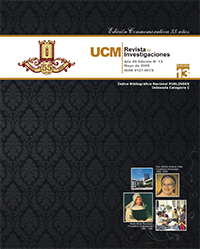Complexity is a problem, not a worldview
Keywords:
No lineality, Frontier science, scientific revolution, researchAbstract
Complexity sciences are neither a method nor a worldview. This widely common understanding is due to the natural tendency by which knowledge is socialized. After presenting what complexity sciences are, I argue that they are not control science, and emphasize that they are problem-based sciences, namely, on frontier problems. Finally, I situate complexity sciences as cutting-edge science.
References
Barabasi, A. L. (2003). Linked. How everything is connected to everything else and what it means for business, science, and everyday life. New York: A Plume Book.
Barrat, A.; Barthélemy, M. & Vespignani, A. (2008). Dynamical processes on complex networks. Cambridge: Cambridge University Press.
Beal, J. C. & Restall, G. (2006). Logical pluralism. Oxford: Oxford University Press.
Echeverría, J. (2003). La revolución tecnocientífica. Madrid: F.C.E.
Garson, J. W. (2006). Modal logic for philosophers. Cambridge: Cambridge University Press.
Gembillo, G. (2008). Le polilogiche della complessità. Metamorfosi della ragione da Aristote a Morin. Firenze: Le Lettere.
Gleick, J. (1988). Caos. La creación de una ciencia. Barcelona: Seix Barral.
Goble, L. (Ed.). (2005). The blackwell guide to philosophical logic. Blackwell.
Grayling, A. C., (1997). An introduction to philosophical logic. Blackwell.
Lederman, L. M., & Hill, C. T. (2006). La simetría y la belleza del universo. Barcelona: Tusquets.
Lorenz, E. N. (2000). La esencia del caos. Un campo de conocimiento que se ha convertido en parte importante del mundo que nos rodea. Madrid: Debate.
Maldonado, C. E. (2005). Termodinámica y complejidad. Una introducción para las ciencias sociales y humanas. Bogotá: Universidad Externado de Colombia.
Mandelbrot, B. (1996). Los objetos fractales. Forma, azar y dimensión. Barcelona: Tusquets.
Mandelbrot, B. (1997). La geometría fractal de la naturaleza. Barcelona: Tusquets.
Mares, E. D. (2007). Relevant logic. A philosophical interpretation. Cambridge: Cambridge University Press.
Mitchell, M. (2009). Complexity: a guided tour. Oxford: Oxford University Press.
Nicholis, G. & Prigogine, I. (1977). Self-organization in nonequilibrium systems. New York: Wiley-Intersciences.
Nicholis, G. & Prigogine, I. (1987). La estructura de lo complejo. En el camino hacia una nueva comprensión de las ciencias. Madrid: Alianza.
Palau, G. (2002). Introducción filosófica a las lógicas no clásicas. Barcelona: Universidad de Buenos Aires-Gedisa.
Peña, L. (1993). Introducción a las lógicas no clásicas. México: Universidad Nacional Autónoma de México.
Prigogine, I. (1962a). Introduction to nonequilibrium thermodynamics. New York: Wiley-Interscience.
Prigogine, I. (1962b). Nonequilibrium statistical mechanics. New York: Wiley.
Prigogine, I. (1977). Nobel lecture in chemistry. Time, structure and fluctuations.
Prigogine, I. (1980). From being to becoming: Time and complexity in the physical sciences. San Francisco: W. H. Freeman and Co.
Prigogine, I. (1993a). ¿Tan sólo una ilusión? Una exploración del caos al orden. Barcelona: Tusquets.
Prigogine, I. (1993b). El nacimiento del tiempo. Barcelona: Tusquets.
Prigogine, I. (1996a). El fin de las certidumbres. Santiago de Chile: Andrés Bello.
Prigogine, I. (1996b). El tiempo y el devenir. Coloquio de Cerisy. Barcelona: Gedisa.
Prigogine, I. (1999). Las leyes del caos. Barcelona: Crítica.
Prigogine, I. (2003). Is future given? World Scientific.
Prigogine, I., & Stengers, I. (1984). Order out of chaos: Man's dialogue with nature. New York: Bantam Books.
Prigogine, I., & Stengers, I. (1990). La nueva alianza: Metamorfosis de la ciencia (2nd ed.). Madrid: Alianza.
Prior, A. N. (2003). Papers on time and tense (New Edition). Oxford: Oxford University Press.
Reynoso, C. (2006). Complejidad y caos. Una exploración antropológica. Buenos Aires: SB, Colección Complejidad Humana.
Ruelle, D. (1995). Azar y caos. Madrid: Alianza.
Scott, R. (2007). Non-linear science. Springer Verlag.
Solé, R. (2009). Redes complejas. Del genoma a internet. Barcelona: Tusquets.
Strogatz, S. (2003). Sync. How order emerges from chaos in the universe, nature, and daily life. New York: Hyperion.
Thom, R. (1990). Esbozo de una semiofísica. Física aristotélica y teoría de las catástrofes. Barcelona: Gedisa.
Thom, R. (1993). Parábolas y catástrofes. Entrevista sobre matemáticas, ciencia y filosofía. Barcelona: Tusquets.
Thom, R. (1997). Estabilidad structural y morfogénesis. Ensayo de una teoría general de los modelos. Barcelona: Gedisa.
Watts, D. J. (2002). Six degrees. The science of a connected age. New York/London: W. W. Norton & Co.
Woodcock, A., & Avis, M. (1994). Teoría de las catástrofes. Madrid: Cátedra.
Zeeman, E. C. (1977). Catastrophe theory. Selected papers 1972-1977. Reading, MA: Addison-Wesley Publishing Co.
Downloads
Published
How to Cite
Issue
Section
License
Copyright (c) 2009 Revista de Investigaciones

This work is licensed under a Creative Commons Attribution-NonCommercial 4.0 International License.
Attribution — You must give appropriate credit, provide a link to the license, and indicate if changes were made. You may do so in any reasonable manner, but not in any way that suggests the licensor endorses you or your use.
NonCommercial — You may not use the material for commercial purposes.
This work is licensed under a Creative Commons Attribution-NonCommercial 4.0 International License.








